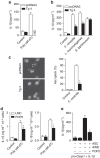Pyrin-only protein 2 limits inflammation but improves protection against bacteria
- PMID: 28580947
- PMCID: PMC5512670
- DOI: 10.1038/ncomms15564
Pyrin-only protein 2 limits inflammation but improves protection against bacteria
Abstract
Pyrin domain-only proteins (POPs) are recently evolved, primate-specific proteins demonstrated in vitro as negative regulators of inflammatory responses. However, their in vivo function is not understood. Of the four known POPs, only POP2 is reported to regulate NF-κB-dependent transcription and multiple inflammasomes. Here we use a transgenic mouse-expressing POP2 controlled by its endogenous human promotor to study the immunological functions of POP2. Despite having significantly reduced inflammatory cytokine responses to LPS and bacterial infection, POP2 transgenic mice are more resistant to bacterial infection than wild-type mice. In a pulmonary tularaemia model, POP2 enhances IFN-γ production, modulates neutrophil numbers, improves macrophage functions, increases bacterial control and diminishes lung pathology. Thus, unlike other POPs thought to diminish innate protection, POP2 reduces detrimental inflammation while preserving and enhancing protective immunity. Our findings suggest that POP2 acts as a high-order regulator balancing cellular function and inflammation with broad implications for inflammation-associated diseases and therapeutic intervention.
Conflict of interest statement
The authors declare no competing financial interests.
Figures






Similar articles
-
Uncoupling of Pyrin-only protein 2 (POP2)-mediated dual regulation of NF-κB and the inflammasome.J Biol Chem. 2011 Nov 25;286(47):40536-47. doi: 10.1074/jbc.M111.274290. Epub 2011 Oct 5. J Biol Chem. 2011. PMID: 21976665 Free PMC article.
-
IFN-γ extends the immune functions of Guanylate Binding Proteins to inflammasome-independent antibacterial activities during Francisella novicida infection.PLoS Pathog. 2017 Oct 2;13(10):e1006630. doi: 10.1371/journal.ppat.1006630. eCollection 2017 Oct. PLoS Pathog. 2017. PMID: 28968459 Free PMC article.
-
Central Role of the NF-κB Pathway in the Scgb1a1-Expressing Epithelium in Mediating Respiratory Syncytial Virus-Induced Airway Inflammation.J Virol. 2018 May 14;92(11):e00441-18. doi: 10.1128/JVI.00441-18. Print 2018 Jun 1. J Virol. 2018. PMID: 29593031 Free PMC article.
-
Bacterial recognition pathways that lead to inflammasome activation.Immunol Rev. 2015 May;265(1):112-29. doi: 10.1111/imr.12289. Immunol Rev. 2015. PMID: 25879288 Free PMC article. Review.
-
Francisella Inflammasomes: Integrated Responses to a Cytosolic Stealth Bacterium.Curr Top Microbiol Immunol. 2016;397:229-56. doi: 10.1007/978-3-319-41171-2_12. Curr Top Microbiol Immunol. 2016. PMID: 27460813 Review.
Cited by
-
LncRNA-induced lysosomal localization of NHE1 promotes increased lysosomal pH in macrophages leading to atherosclerosis.J Biol Chem. 2025 Jun;301(6):110246. doi: 10.1016/j.jbc.2025.110246. Epub 2025 May 16. J Biol Chem. 2025. PMID: 40383150 Free PMC article.
-
Accelerated NLRP3 inflammasome-inhibitory peptide design using a recurrent neural network model and molecular dynamics simulations.Comput Struct Biotechnol J. 2023 Sep 29;21:4825-4835. doi: 10.1016/j.csbj.2023.09.038. eCollection 2023. Comput Struct Biotechnol J. 2023. PMID: 37854633 Free PMC article.
-
Design principles for inflammasome inhibition by pyrin-only-proteins.Elife. 2024 Jan 22;13:e81918. doi: 10.7554/eLife.81918. Elife. 2024. PMID: 38252125 Free PMC article.
-
CARD-only proteins regulate in vivo inflammasome responses and ameliorate gout.Cell Rep. 2023 Mar 28;42(3):112265. doi: 10.1016/j.celrep.2023.112265. Epub 2023 Mar 16. Cell Rep. 2023. PMID: 36930645 Free PMC article.
-
COPs and POPs Patrol Inflammasome Activation.J Mol Biol. 2018 Jan 19;430(2):153-173. doi: 10.1016/j.jmb.2017.10.004. Epub 2017 Oct 10. J Mol Biol. 2018. PMID: 29024695 Free PMC article. Review.
References
-
- Takeda K., Kaisho T. & Akira S. Toll-like receptors. Annu. Rev. Immunol. 21, 335–376 (2003). - PubMed
-
- Martinon F., Burns K. & Tschopp J. The inflammasome: a molecular platform triggering activation of inflammatory caspases and processing of proIL-beta. Mol. Cell 10, 417–426 (2002). - PubMed
-
- Martinon F., Mayor A. & Tschopp J. The inflammasomes: guardians of the body. Annu. Rev. Immunol. 27, 229–265 (2009). - PubMed
Publication types
MeSH terms
Substances
Grants and funding
LinkOut - more resources
Full Text Sources
Other Literature Sources
Molecular Biology Databases

